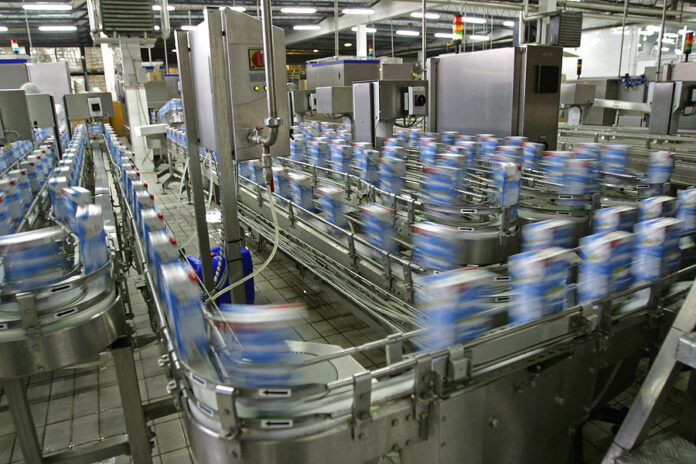
Key takeaways:
- Cost crisis drives tech adoption: Dairy executives shifted to cost management as their #1 priority, creating urgency for efficiency-focused technology investments.
- Three proven strategies work: AI-driven predictive maintenance, automated quality controls, and integrated workforce management systems are solving the talent shortage and equipment reliability challenges.
- Early movers gain lasting advantage: With 80% of dairy leaders expecting 3%+ growth, companies implementing smart manufacturing now will build sustainable operational advantages over competitors still using manual processes.
Cost management has become the top priority for almost seven in 10 dairy industry executives, a giant leap from 48% in 2023, as reported by McKinsey & Company. These dairy leaders are facing the same operational headwinds as the rest of the food industry — inflation squeezing margins, skilled labor shortages, equipment reliability issues, and the constant pressure to do more with less — calling for actionable solutions.
Here’s what dairy executives told McKinsey about their biggest challenges — and the three technology strategies that are actually moving the needle.
The perfect storm: Why operations took center stage
Rising costs are everywhere. Raw materials, logistics, trucking — everything got more expensive while volume demands increased. Domestic cheese consumption grew 1.5%, butter shot up 5.8%, and cottage cheese demand surged 12%. Growth should be good news, but it creates capacity crunches when you can barely staff existing lines.
The talent crisis deepened. Despite flexible schedules, higher pay, and creative shift patterns (one dairy executive said their plants run 18 different shift combinations), 67% of dairy leaders still cite talent as a top priority. The real pain point? Only 60% believe they’re filling roles with the best-fit talent, especially in skilled manufacturing positions.
Equipment keeps breaking down. Leaders consistently cite the challenge of finding enough maintenance technicians. This shortage translates to longer downtimes when critical equipment fails.
Sound familiar? Here’s how forward-thinking operations leaders are responding.
Strategy 1: AI-driven predictive maintenance
The problem: Equipment failures are killing productivity, and there aren’t enough skilled technicians to respond quickly.
The solution: Companies can deploy AI-powered maintenance systems that predict failures before they happen. Instead of reactive repairs, smart sensors monitor equipment health 24/7 and flag issues early.
Real impact: AI copilots guide less-experienced technicians through complex repairs, effectively multiplying the skilled workforce. This lets your best people focus on high-value preventive work instead of constant firefighting.
Implementation tip: Start with your most critical production lines. Install vibration sensors, temperature monitors, and pressure gauges connected to an AI platform. The data will reveal failure patterns you never noticed — and give you two to four weeks’ advance warning on major repairs.
ROI reality check: If a typical processor implementing predictive maintenance reduces unplanned downtime by 20 to 40%, they could potentially save millions in lost production and emergency repair costs.
Strategy 2: Automated quality and process controls
The problem: Labor shortages mean fewer eyes on production lines, but quality standards can’t slip.
The solution: Smart manufacturing systems can automate quality checks and optimize processes in real-time. AI analyzes production data continuously, catching deviations before they become costly problems.
Key technology and initiatives:
- Automated vision systems that inspect packaging for defects
- Real-time monitoring of temperature, pH, and other critical parameters
- Predictive algorithms that adjust processes to maintain consistency
- Digital dashboards that give plant managers instant visibility across all lines
The talent multiplication effect: Instead of needing experienced operators on every line, you can deploy less-experienced workers with smart systems that guide their decisions and catch their mistakes.
Strategy 3: Integrated workforce management systems
The problem: It’s difficult to manage complex shift patterns, track productivity, and develop skills across a multi-generational workforce.
The solution: Digital platforms can optimize scheduling, track performance, and deliver targeted training where it’s needed most.
Key technology and initiatives:
- Dynamic scheduling that automatically fills shifts based on skills and availability
- Performance analytics that identify top performers and training opportunities
- Mobile-first interfaces that work for both floor workers and managers
- Gamification elements that boost engagement and retention
Training revolution: Instead of lengthy classroom sessions, workers get bite-sized digital training modules they can complete during downtime. AI identifies skill gaps and delivers personalized learning paths.
Retention potential: Early adopters of integrated workforce management systems often see meaningful improvements in retention rates, particularly among younger workers who expect digital-first experiences.
Making smart technology investments
Most dairy leaders (79%) are increasing manufacturing innovation investments over the next three to five years because they’ve learned that efficiency gains pay for themselves quickly.
But success requires a strategic approach:
- Start small, scale fast: Pick one critical pain point (equipment downtime, quality issues, or scheduling chaos) and prove ROI before expanding.
- Focus on integration: Standalone systems create data silos. Choose platforms that talk to each other and provide unified dashboards.
- Plan for change management: Technology only works if people use it. Budget a portion of your implementation costs for training and adoption support.
Dairy executives shifted priorities because operational excellence became survival, not strategy. The same pressure is hitting food manufacturers everywhere. Leaders who implement smart manufacturing technologies now will build sustainable advantages while others struggle with manual processes.

Credit: Source link












